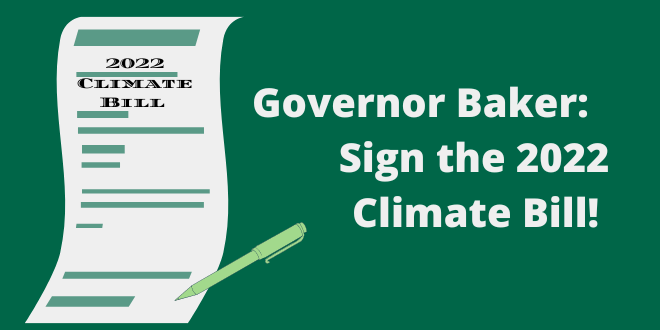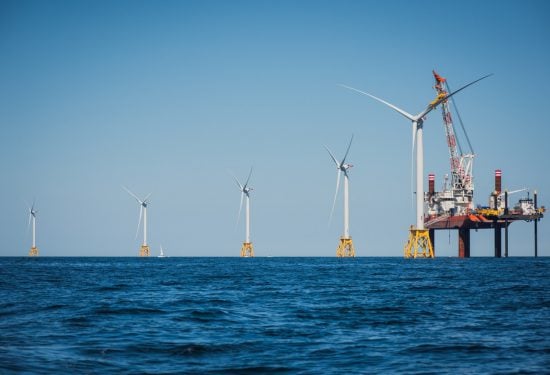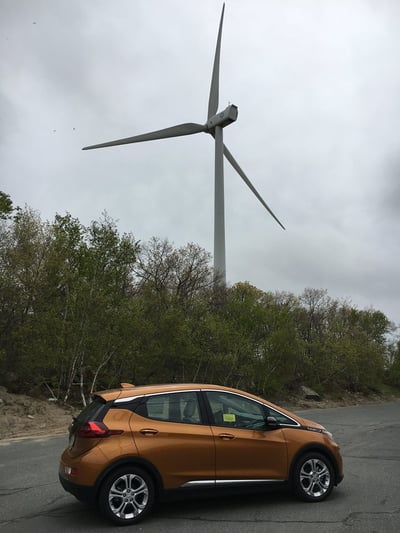 On Thursday, the Massachusetts House and Senate both passed a major new climate bill, An Act Driving Clean Energy and Offshore Wind. The legislation now goes to Governor Baker for signature. The bill is basically what we expected: a combination of the House’s emphasis on offshore wind, the Senate’s emphasis on electric transportation, and some new policies in other areas. Overall, we are very pleased with the 96-page bill. Here are our views on some of the key provisions – and what you can do to get this over the finish line.
On Thursday, the Massachusetts House and Senate both passed a major new climate bill, An Act Driving Clean Energy and Offshore Wind. The legislation now goes to Governor Baker for signature. The bill is basically what we expected: a combination of the House’s emphasis on offshore wind, the Senate’s emphasis on electric transportation, and some new policies in other areas. Overall, we are very pleased with the 96-page bill. Here are our views on some of the key provisions – and what you can do to get this over the finish line.
(Also, thank you! We have been working hard for months to make sure this bill comprehensively addresses the challenges we face – and sets the Commonwealth on the path needed to reach 50% economy-wide emissions reductions by 2030. We couldn’t have had the impact we had without the 750+ members like you who reached out to their legislators this past week to keep up the pressure! Thank you!)
First Up, Offshore Wind
Offshore wind (OSW) is a critical resource for Massachusetts. Wind off our shores is plentiful, cheap, and steady – OSW will be able to supply a lot of the power that is currently being generated by the combustion of fracked gas, especially in winter months. It also presents a huge economic growth opportunity for the Commonwealth. This climate bill sets up the Commonwealth to really harness this power and all of its potential benefits. Previous legislation has required electric distribution companies (read: Eversource, National Grid, and Unitil) to procure a certain amount of OSW. This new climate bill ups the ante even further: by 2027, distribution companies will be required to solicit more bids for a total commitment of 5,600 megawatts of OSW. The bill also includes a list of important factors that will determine which projects win bids, including price, job creation, and wildlife and habitat monitoring. We at Green Energy Consumers are particularly happy to see that OSW projects that are developed in partnership with municipal aggregations will also be given some preference. (As we’ve written before, municipal aggregation is accelerating our transition to clean energy.)

Per the recently released state Clean Energy and Climate Plan, we’re going to need a lot more OSW eventually, especially given uncertainty about the potential for bringing in hydropower from Quebec through Maine. This bill sets us on an appropriate timeline given the lead time it takes to build projects. Before long, we expect the legislature to order another major procurement.
Addressing Transportation, Our #1 Emitter
Transportation is the largest source of greenhouse gas (GHG) emissions in the state. To fight climate change, we have to simultaneously invest in alternatives to personal vehicle travel to reduce overall vehicle-miles-traveled AND rapidly electrify everything on our roads. When the Senate climate bill came out in the spring, we were glad to see it address lots of aspects of the transportation sector. The good news is: a lot of that made it into the final climate bill! Specifically:
- An Electric Vehicle Adoption Fund will provide rebates to individual and corporate consumers who purchase new or used electric cars. The language in the bill changes the structure of the state’s current MOR-EV program by (a) increasing the price cap from $50,000 to $55,000, (b) increasing the rebate from $2,500 to $3,500-$5,000 for light-duty vehicles, (c) offering rebates for used vehicles (yay!), and (d) offering a higher rebate for low-income drivers or people trading in gas-powered cars. It also retains the rebate for medium- and heavy-duty vehicles, hints at a potential point-of-sale structure, and stresses the importance of culturally and linguistically appropriate education and outreach.
- An EV Infrastructure Coordinating Council will oversee the building out of charging stations, including those paid for by a new Charging Infrastructure Deployment Fund. The Council is tasked with planning out infrastructure that is “equitable, interconnected, accessible and reliable” and sufficient to support state’s EV adoption targets for 2025 and 2030 (200,000 and 900,000 EVs, respectively).
- Support for smart charging: Utilities will be required to provide rebates to EV drivers who charge during off-peak periods commensurate with the significantly lower costs associated with off-peak power. Crucially, these rebates will include not just the differential value of generating electricity at different times but also avoided capacity, transmission, and distribution costs; improved grid reliability; avoided greenhouse gas emissions; and (vii) public health benefits. We advocated hard for this provision because smart-charging is a win for everyone, so we’re thrilled to see this make it into the final bill!
- Gas-Car Phase Out: Effective December 31, 2035, all new cars sold in the Commonwealth must be electric. The bill achieves this in two ways: (1) by directly stating that it will be a violation for a car dealership to sell a vehicle that isn’t zero-emission after 2035, and (2) further committing Massachusetts to adopting California’s Advanced Clean Cars II standards, which will ramp up EV sales from now to reach 100% in 2035.
- Public Transit & School Buses: The bill requires all MBTA bus purchases to be electric by 2030 and the full fleet of buses to be electric by 2040 and directs the deployment of these buses to prioritize environmental justice communities. It also directs the Massachusetts Department of Transportation (MassDOT) to assist Regional Transit Authorities (RTAs) with bus electrification and write a report to the legislature with recommendations on zero-emission bus incentives.
- Lots of other good stuff: In addition to these key points, the bill calls for more publicly available data on vehicle purchases and vehicle-miles traveled, a program and/or regulations to reduce GHG emissions from transportation-network companies like Uber and Lyft, updating building codes to include minimum EV charging requirements, and a plan to increase reliability of charging stations on public lots like those along the Mass Pike. All good stuff!
Green Energy Consumers has been engaged with legislators for several months on all of these EV-related provisions. As we reported back in November, the public is ready to embrace EV technology, as evidenced by a survey indicating strong support for phasing out gasoline. We assume public support for EV is even stronger today, considering high gasoline prices and the invasion of Ukraine.
 Electric transportation powered by wind!
Electric transportation powered by wind!
How About Heating?
Heating, like transportation, is a thorny sector to decarbonize because of the sheer number of actors who need to change their behavior. The climate bill addresses this sector in two main ways – looking at buildings and looking at gas infrastructure.
Buildings
The climate bill will require gas and electric utilities to report the energy consumption of large buildings (20,000 square feet and above) to the state and requires the state to make that information publicly available. The idea is that building owners will be able to compare their usage to others of similar size and type and, in turn, that will encourage emission reductions over time. Eventually, we hope that mandatory reporting will lead to standards to bring down emissions, but the reporting requirements are a good start.
In addition, the bill determines that the Department of Energy Resources (DOER) shall administer a pilot program that would allow up to ten cities and towns to restrict or prohibit the construction of buildings that are not fossil fuel-free. The idea is to accelerate the adoption of buildings heated by ground-source and air-source heat pumps.
 We need about 1,000,000 heat pumps installed by 2030.
We need about 1,000,000 heat pumps installed by 2030.
The Future of Gas
In 2021, the legislature passed the Climate Roadmap bill, which requires economy-wide GHG emissions to be 85% lower in 2050 than they were in 1990. Governor Baker’s Clean Energy and Climate Plan goes even further, aiming for a 90% reduction by 2050. To reach 85% or more, almost every single building in the Commonwealth will have to be heated by clean electricity rather than by gas, oil, or propane. Given that most buildings are heated by gas today, that has enormous implications for consumers and utilities.
In response, this new climate bill requires the Department of Public Utilities (DPU) to convene a stakeholder working group to develop recommendations for making the changes necessary to reach the legal emission limits. The working group will grapple with major questions about how to equitably and efficiently maintain an expensive gas distribution system while simultaneously reducing the number of gas customers and overall gas consumption. A report from the group will be due July 31, 2023.
Grid Modernization
Every change we’ve discussed so far – bringing more offshore wind online, electrifying transportation, converting from combustion to heat pumps – will require a robust and resilient electric grid. The climate bill acknowledges that there’s work to be done to modernize our grid in anticipation of this transition: it requires utilities to submit grid modernization plans to a Grid Modernization Advisory Council by April 1, 2023. The plans will consider necessary investments in distribution and transmission infrastructure, non-wires alternatives, reliability, resilience, enablement of distributed energy resources, increased transportation and building electrification, ratepayer impacts, and emission reductions.
(Related to all of this, the electric utilities already have ongoing dockets before the DPU regarding EV infrastructure and grid modernization. Green Energy Consumers intervened in these dockets, advocating for the public interest, and we are awaiting decisions by the DPU, probably later this summer. When the orders are made public, we will report via blog and webinar.)
Workforce Development
All of these efforts to reduce economy-wide GHG emissions in Massachusetts present a huge opportunity for growth for the Commonwealth. In fact, the governor’s Clean Energy and Climate Plan projects 22,000 new good-paying jobs by 2030. This climate bill recognizes that potential and allocates funding (on the order of $12 million per year!) to grow and diversify the clean energy workforce through job training and other methods. The Massachusetts Clean Energy Center will spearhead most of this work, particularly in regards to the OSW industry. The bill also gives OSW projects preference if they include plans for hiring a diversity of employees and create specific opportunities for low-income people.
So, What’s Next?
Governor Baker has ten days to sign this bill into law before the end of the session on July 31. He needs to hear from all of us loud and clear that this bill needs his signature, not a full or partial veto.
The most effective thing you can do is call the Governor’s office with a simple message: Governor Baker, sign the climate bill! The number is:
(617) 725-4005.
You can also use our form to send written comments to his office. It'll take less than a minute!
Even once the bill is signed into law, the work does not end. Markets and technologies change rapidly and that means government policy must change often too. So, we expect that the new governor and legislature will go back to the drawing board in 2023 and address more issues. And of course, legislation is not everything - the implementation of policy is assigned to the executive branch. So we will all need to keep the pressure up on Governor Baker and his successor to administer the various funds identified in this bill, convene the working groups, create the programs, administer the pilots, and issue the regulations. One big issue that we expect to be resolved with other legislation before the end of the session is the funding source for the provisions in this bill – stay tuned.
P.S. Want to learn even more? Join us on August 10 at noon for a webinar diving into the climate bill. RSVP here.




Comments